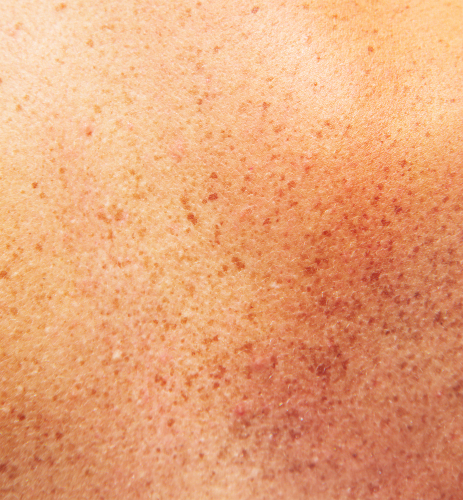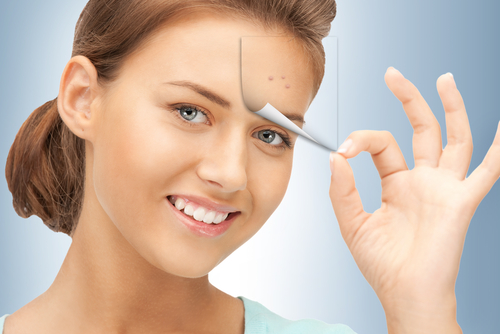Many of us want our skin, regardless of its color or complexion, to look equal throughout. This universal desire is the main reason makeup is so popular.
Even though many of us know that makeup and airbrushing are the reason that the faces of people on TV or in magazines look consistent if not perfect, there is always the tendency to get discouraged when certain spots on your skin appear darker than others. Just remember that no person's skin is perfectly homogenized, and you are certainly not alone.
Dark spots on the skin are also known as hyperpigmentation. All types of hyperpigmentation are the result of an uneven increase in the cell darkening pigment, called melanin, within the skin.
This uneven distribution of melanin makes certain areas of the skin look darker and more pigmented than the surrounding areas. How dark or light the hyperpigmentation appears depends on a number of factors, including how much melanin has been deposited into the skin, and in what particular layer of the skin the pigment resides.
 No matter where within the skin that pigment is, the process of how the melanin develops is the same. A number of triggers can begin the process of hyperpigmentation, including ultraviolet light, hormone changes, acne, trauma, and side effects of certain medications.
No matter where within the skin that pigment is, the process of how the melanin develops is the same. A number of triggers can begin the process of hyperpigmentation, including ultraviolet light, hormone changes, acne, trauma, and side effects of certain medications.
In each case, the trigger stimulates an enzyme called tyrosinase within the skin, which begins the creation of melanin by the skin cell. Once the melanin is produced, small pigment packets called melanosomes deposit within the affected cells, giving them more color than the surrounding non-triggered cells.
When this hyperpigmentation develops within superficial cells, the color tends to be more diffuse and lighter. When the same process occurs deeper into the dermal layer of the skin, the color is generally darker, more difficult to treat, and requires more treatments to lighten the color.
As you may have guessed, there are distinct types of discoloration or hyperpigmentation, and they are not the same in terms of treatment. The four basic types of dark spots are:
- Melasma- This is generally characterized by large and patchy areas of color, and are usually associated with hormonal changes in women. Although it can happen with changes in hormonal medication, it is most commonly associated with pregnancy, and is frequently referred to as "the mask of pregnancy". This type of hyperpigmentation can be very difficult to treat as it affect multiple levels of the skin, both superficial and deeper. Usually treatments, when effective, result in a more gradual lightening as the color is basically being removed slowly layer by layer.
- Post-Inflammatory Hyperpgimentation (PIH)- This is caused by direct damage to the skin and is very common around acne scars, surgical or traumatic scars, or injuries. PIH is most common in those with more pigment in the skin to begin with. Treatments involve the removal of the color while also treating causes of inflammation to prevent further discoloration.
- Sunspots- These areas are also commonly known as age spots or liver spots (although they have nothing whatsoever to do with the liver). Sunspots are almost totally related to ultraviolet light exposure, and are found most commonly on the face, neck, chest, and hands. These spots appear gradually over time, as the cumulative effect of sun exposure causes the darkening of the skin cells over long periods of time. These spots can be treated and lightened but may return if ultraviolet light exposure persists.
- Freckles- These are lighter dark spots that develop generally in childhood and are usually seen in higher skin types. Freckles can fade over time on their own with good sunscreen use later in life, but they may also progress into sun spots if sun exposure continues and increases over life.
Treatments for any of these condition are based on cause, skin type or complexion, and the depth of the color. Pigmentation therapy can vary on a case-by-case basis.
 Prevention remains the number one hallmark of treatment for hyperpigmentation. Applying sunscreen every day on all exposed skin is mandatory to stop the ongoing damage and to maintain the benefits of more intense treatments we use.
Prevention remains the number one hallmark of treatment for hyperpigmentation. Applying sunscreen every day on all exposed skin is mandatory to stop the ongoing damage and to maintain the benefits of more intense treatments we use.
Sadly, most of the skin lightening products you see advertised on TV either don't work or work so minimally that the expense and effort do not match the results. Exfoliators are the only over-the-counter products that have some hope of success.
By regularly exfoliating the skin over pigmented areas, you will slowly remove damaged pigmented skin cells and eventually start to even out the complexion. On average, it takes the use of an exfoliator for 2-3 months to notice any fading of color.
The next level of treatment is chemical peels. In general, these peels use various strengths of acids to remove layers of skin cells and to remove preferentially pigmented cells.
Lighter peels can be done at home, but more aggressive peels should be done in a spa or office setting, and by a certified aesthetician. For superficial and lighter degrees of hyperpigmentation, chemical peels can be sufficient.
For heavier sun-damaged skin or pigmentation that has been resistant to over-the-counter products and/or chemical peels, lasers are the gold standard. The appropriate wavelength of focused laser light will target the pigmented skin cells, causing them to exfoliate preferentially and resulting in the expedited lightening of dark sun spots of whatever cause.
The laser treatment is one of more common treatments we perform at both Maine Laser Skin Care offices. Especially when it comes to dark spot removal, the results are nothing short of phenomenal.
If you have any questions about hyperpigmentation, or to see if we can treat your spots, call to schedule a free and individualized consultation following the COVID-19 shutdown. We have staff members monitoring the phones in Augusta at (207) 873-2158 and in Scarborough at (207) 303-0125, and they will promptly return your calls.
Until we open our doors again, please continue to stay at home, keep washing your hands, and be safe. We will get together again soon.

